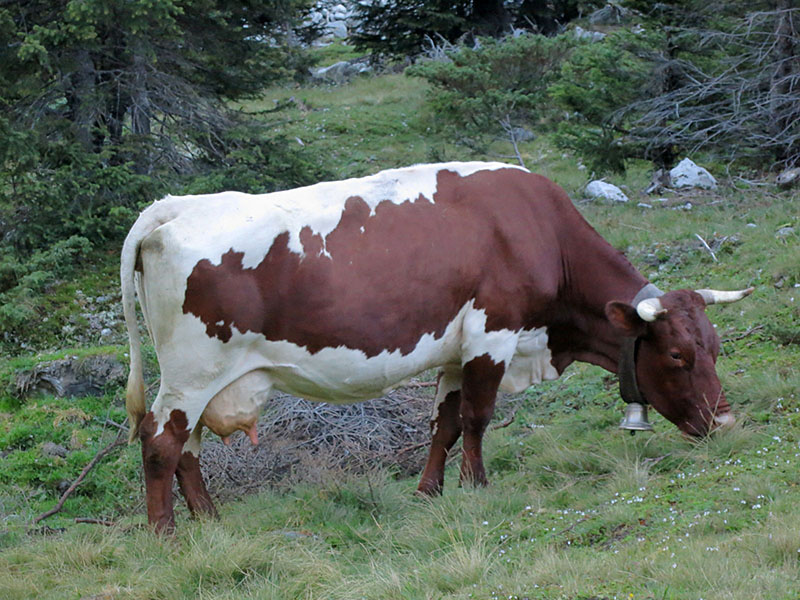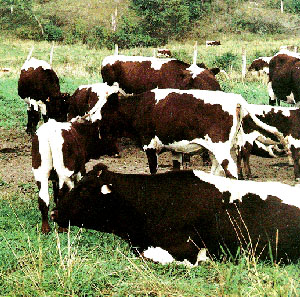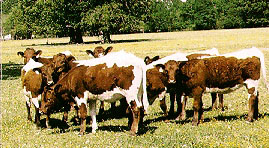Pinzgauer Cattle
Also Known By: Pinzgau, Jocherg Hummel
About 500 AD., Alpine herdsmen,  who ran their cattle on small, widely scattered, rocky pastures, had begun to develop
a breed of red and white cattle from the native red Bavarian cattle. These early cattlemen
selected animals that could withstand the harsh conditions and still produce meat
and milk. Farmers in the highly productive valleys and other lush areas of Bavaria,
developed larger, brown and spotted (flecked) breeds of cattle from the same original,
native seedstock. Later in history, Pinzgauer attained their present form and color.
The designation "Pinzgauer" drives from the "Pinzgau" district in the province of
Salzburg, Austria, and appears for the first time in documents of the 1600's. Herd
books dated in the 1700's show that selective breeding had been going on for some
time, and there are records of exportations of "Pinzgauer Cattle" to Rumania, Czechoslovakia
and Yugoslavia in the 1820's. In 1871 Pinzgauer cattle were sent to the Paris World
Exhibition. In the early 1900's, a number of breeding cattle were exported to South
Africa, which has the second largest herd of fullblood animals in the world today.
who ran their cattle on small, widely scattered, rocky pastures, had begun to develop
a breed of red and white cattle from the native red Bavarian cattle. These early cattlemen
selected animals that could withstand the harsh conditions and still produce meat
and milk. Farmers in the highly productive valleys and other lush areas of Bavaria,
developed larger, brown and spotted (flecked) breeds of cattle from the same original,
native seedstock. Later in history, Pinzgauer attained their present form and color.
The designation "Pinzgauer" drives from the "Pinzgau" district in the province of
Salzburg, Austria, and appears for the first time in documents of the 1600's. Herd
books dated in the 1700's show that selective breeding had been going on for some
time, and there are records of exportations of "Pinzgauer Cattle" to Rumania, Czechoslovakia
and Yugoslavia in the 1820's. In 1871 Pinzgauer cattle were sent to the Paris World
Exhibition. In the early 1900's, a number of breeding cattle were exported to South
Africa, which has the second largest herd of fullblood animals in the world today.
Milk Yield
The milk productivity of Pinzguaer cows is on average 4,000/5,000 kg of milk. The good capacity for eating large amounts of food, good temperament, maternal instinct and remarkable fertility are important elements for justifying using the Pinzguaer breed also for breeding nursing cows.
 Beef production
Beef production
With an intensive fattening the average daily weight increase is about 1,400 g with a slaughter yield of 56-58%. The good meat quality, with first rate marbling, fine fiber and light red color satisfy consumer requirements.
Beef Program
The first attempts at Pinzguaer selection date back to the 18th century. In 1989 the inbreeding programs "Pinzguaer 2000" and "Moet programs" were integrated to develop the double aptitude of the breed, without forsaking such aspects such as resistance and energy.
Characteristics
Horned or Polled, Pinzgauers have pigmented skin under a chestnut red coat and white markings on the back, tail and barrel. They adapt readily and easily to a variety of climates. Eye problems are rare. Smooth hair and firm, flexible skin prevents tick and other insect infestations.
Mature bulls average 2000 pounds and up, while mature females level out at approximately 1,000 to 1,600 pounds. More moderately sized in relation to the "big is better" theory, Pinzgauer progeny still have above average weaning weights, gainability and feed conversion, but they maintain the easy calving ability that cattlemen prefer. Udders are well-formed and hold up well during lactation.
North American Entry
 The first four head of Pinzgauer were imported into Canada in September 1972. Austrian
Fullbloods were first imported to the USA in 1976. Live animals, frozen embryos, and
semen all have been imported to establish fullblood herds and to upgrade the Purebred
Pinzgauers. Pinzgauer as we know them today are the result of rigid performance and
registry demands. The American Pinzgauer Association has a breeding-up program which
allows a producer to breed up to Purebred Pinzgauer (7/8 for females, 15/16 for bulls)
by starting with commercial cows and using Pinzgauer bulls. At the end of 1989, there
were over 30,000 Fullblood and Purebred Pinzgauers in the United States, giving the
cattlemen a world wide genetic base on which to build a Pinzgauer herd.
The first four head of Pinzgauer were imported into Canada in September 1972. Austrian
Fullbloods were first imported to the USA in 1976. Live animals, frozen embryos, and
semen all have been imported to establish fullblood herds and to upgrade the Purebred
Pinzgauers. Pinzgauer as we know them today are the result of rigid performance and
registry demands. The American Pinzgauer Association has a breeding-up program which
allows a producer to breed up to Purebred Pinzgauer (7/8 for females, 15/16 for bulls)
by starting with commercial cows and using Pinzgauer bulls. At the end of 1989, there
were over 30,000 Fullblood and Purebred Pinzgauers in the United States, giving the
cattlemen a world wide genetic base on which to build a Pinzgauer herd.
References
Briggs, H.M. & D.M. Briggs. Modern Breeds of Livestock. Fourth Edition. Macmillan Publishing Co. 1980
Mason, I.L, World Dictionary of Livestock Breeds, Third edition (1988), C.A.B International
